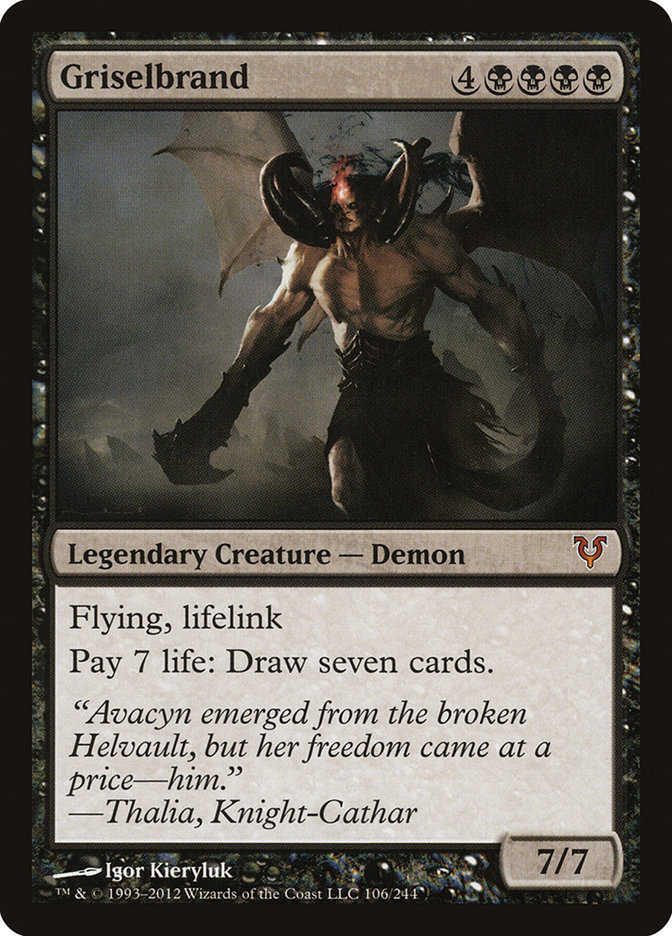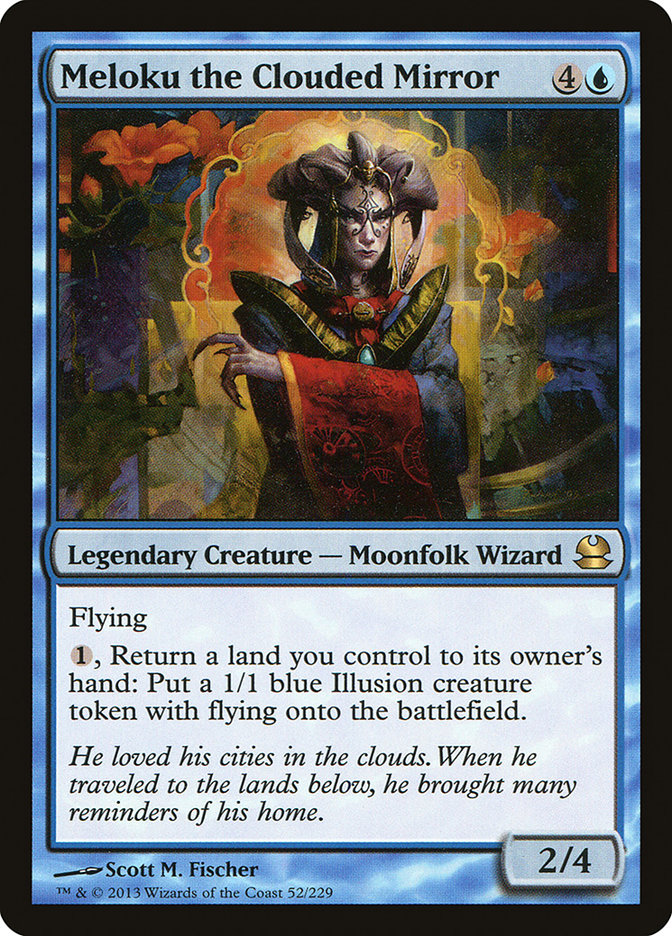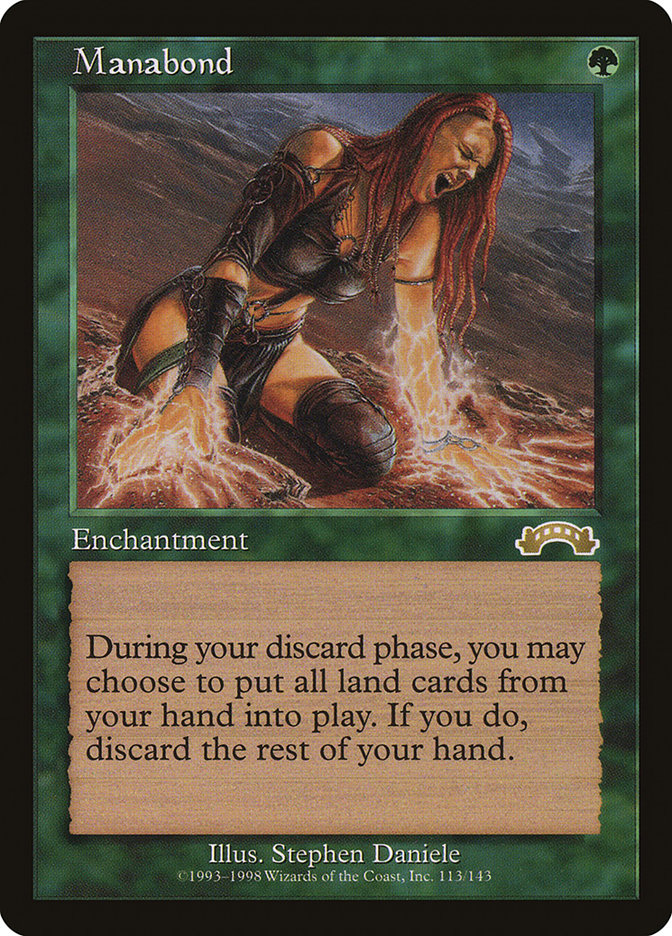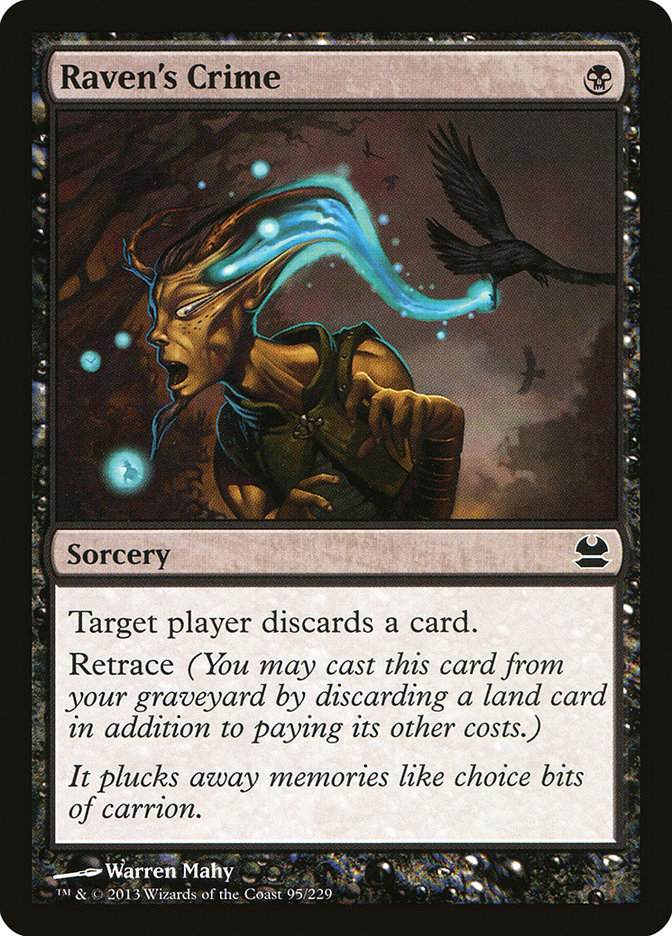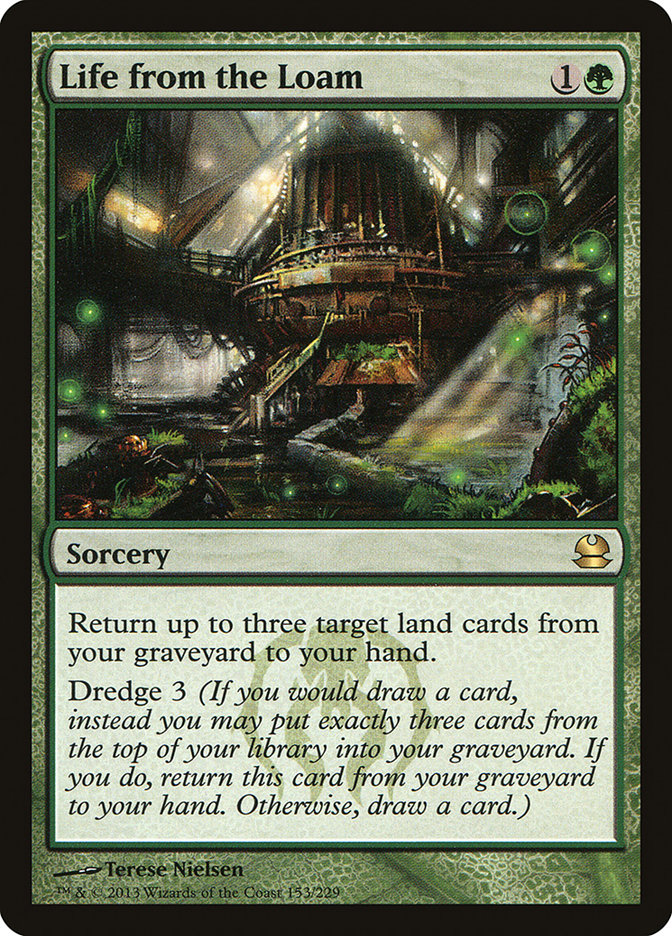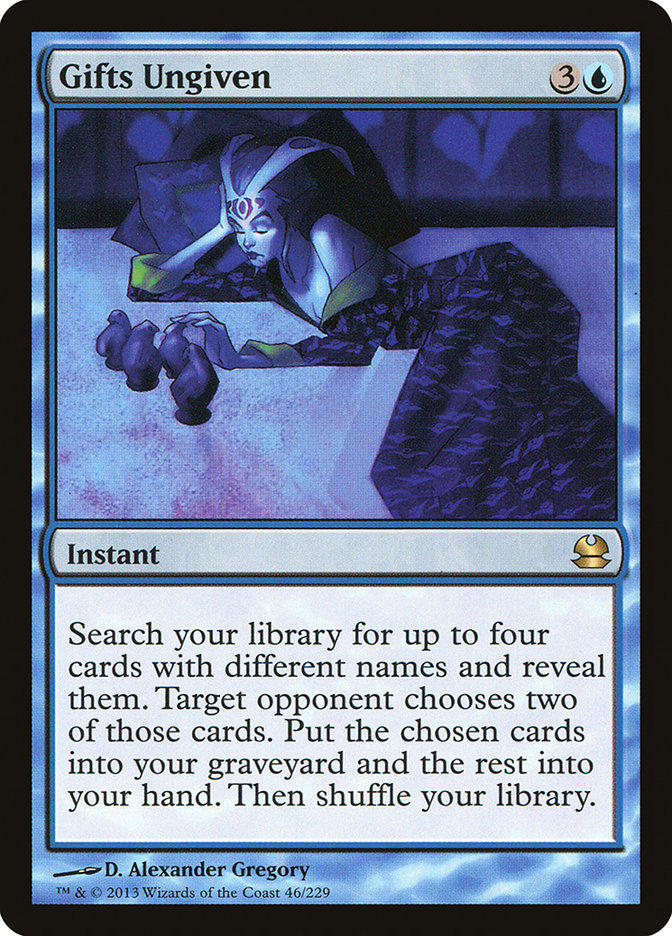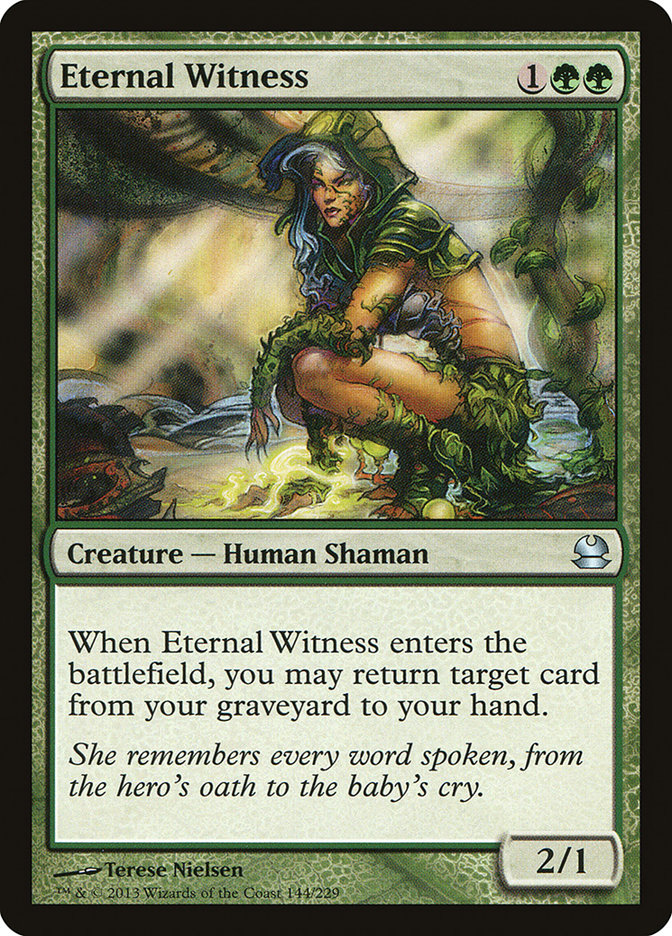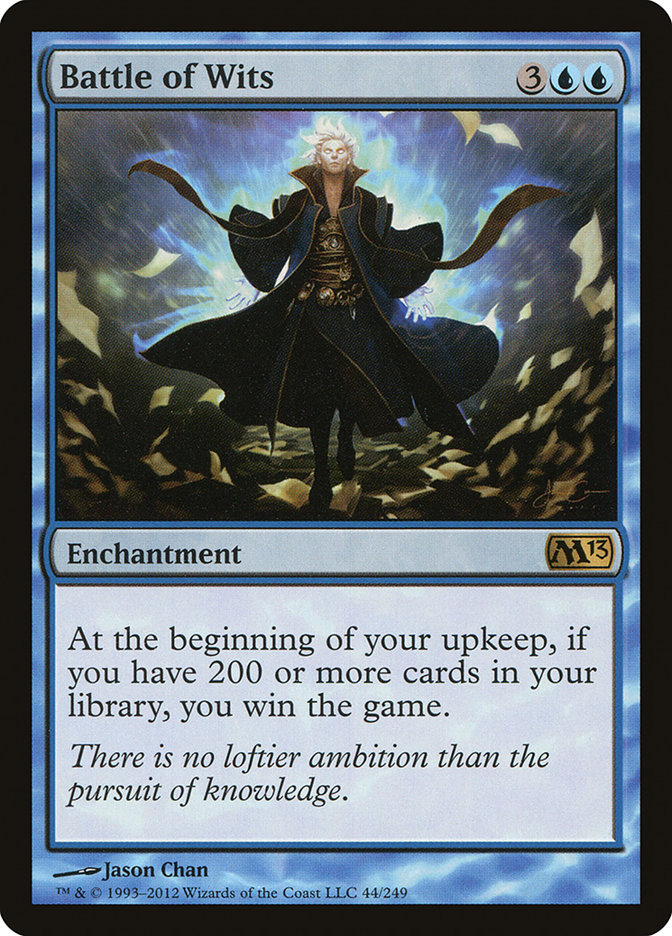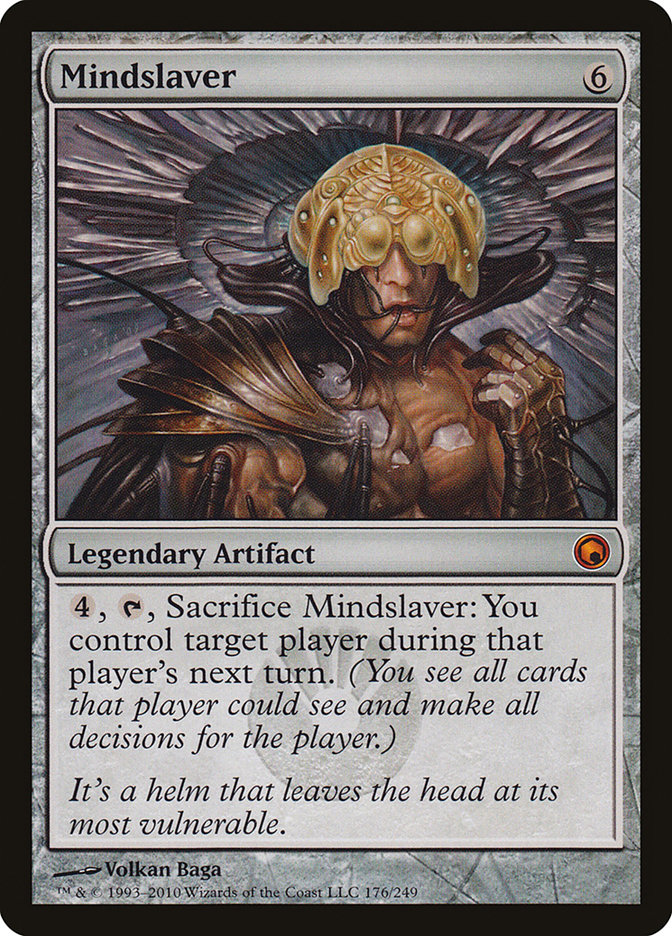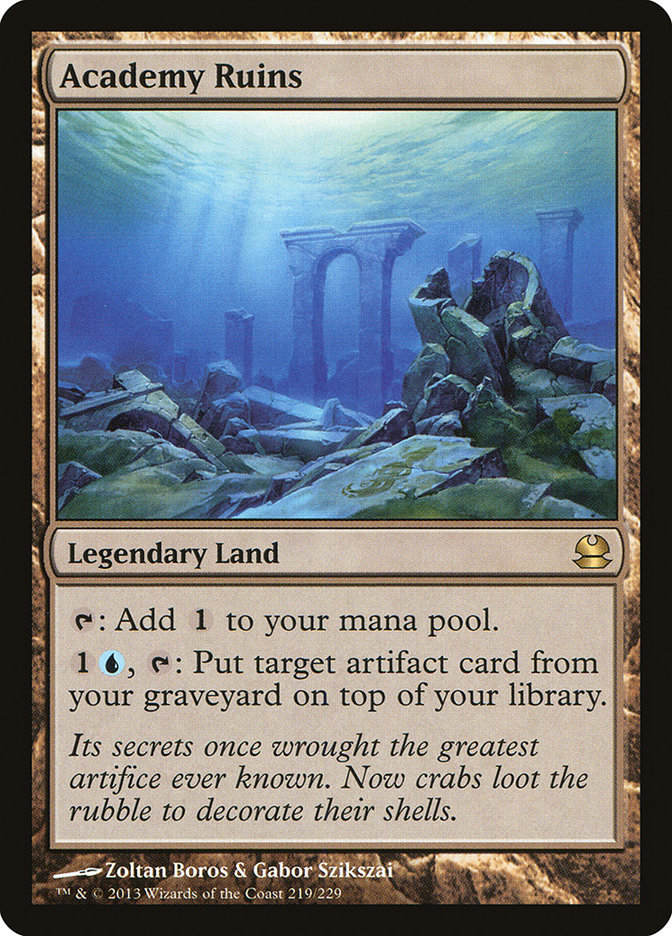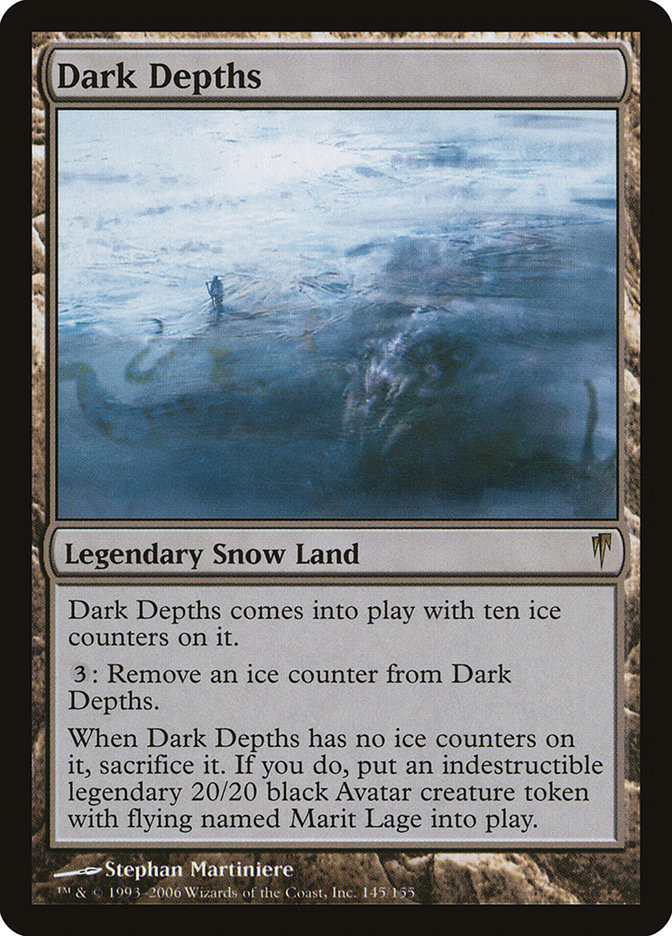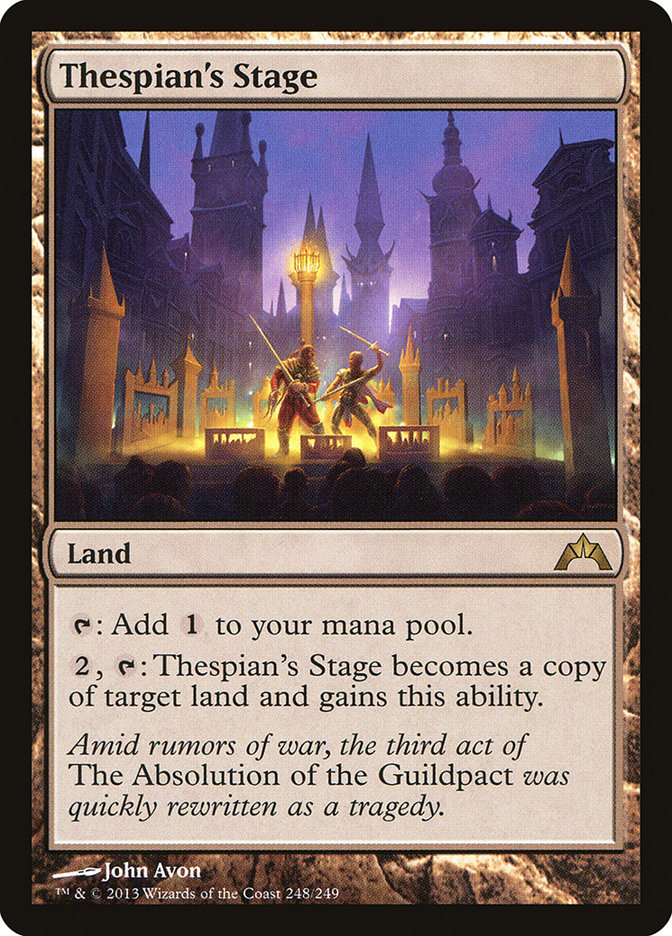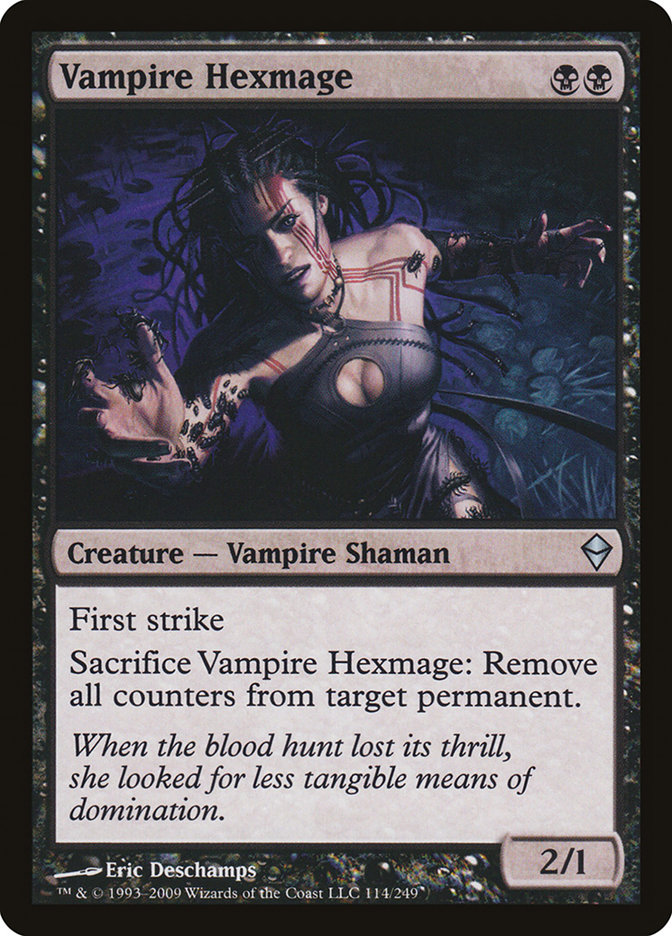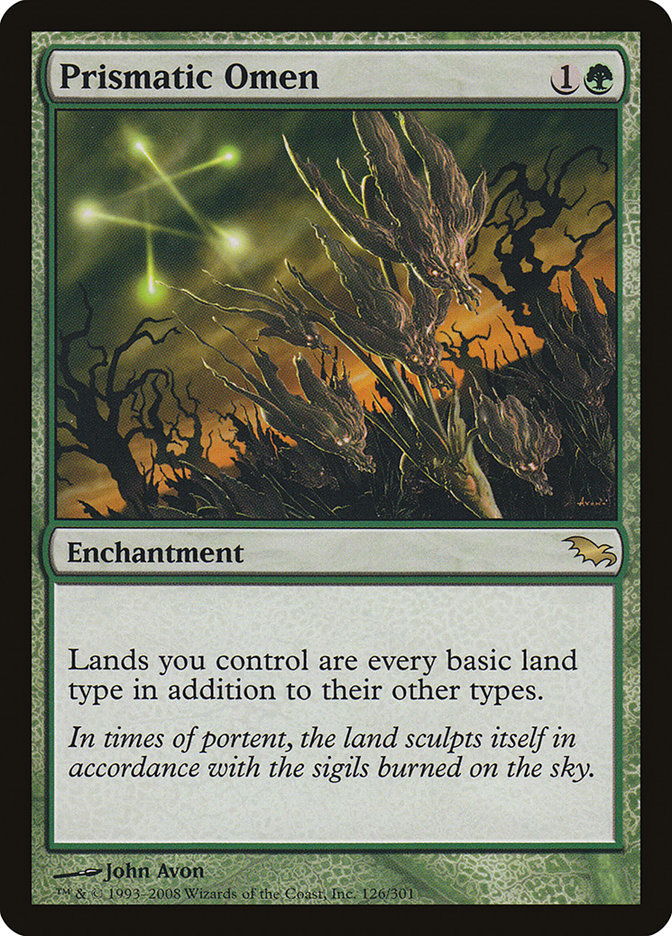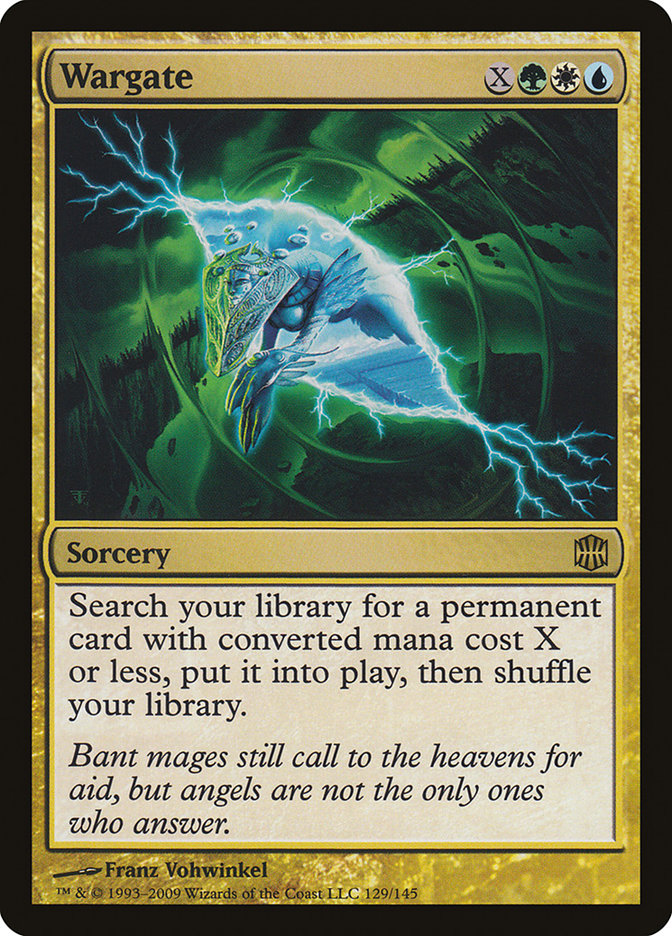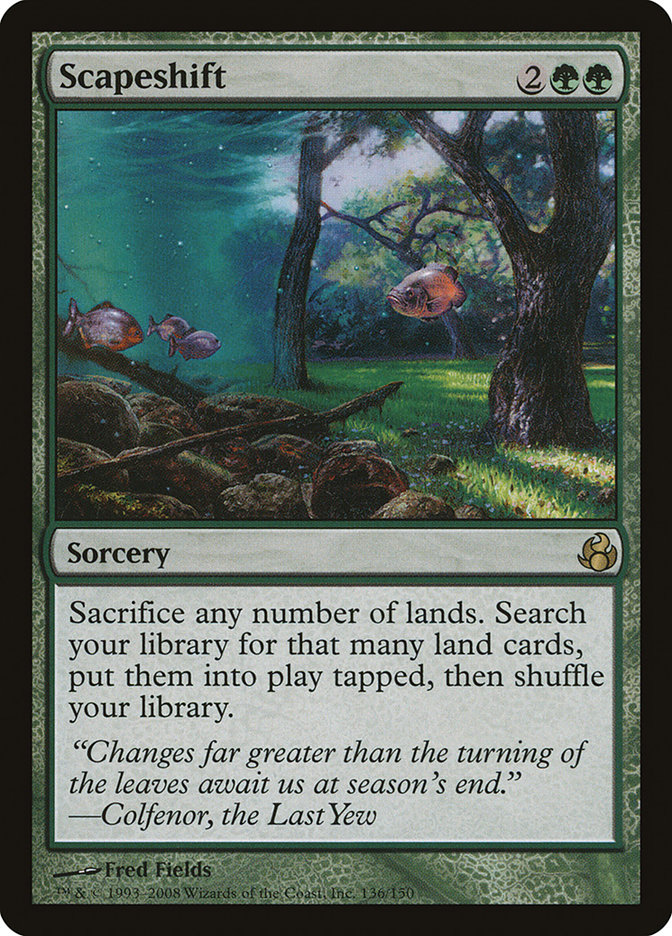How in the world does anyone build a Battle of Wits deck?
It starts with Limited decks. You constantly work to find the best permutation of spells, leaving some on the sidelines. Once you learn how to draft a format and once you learn how to approach building a deck from a sealed pool, you will always work with an overabundance of resources. You learn how to cut, cut, cut until you’ve found the best of the best—the cards that you want to draw the most. You understand after a while that you shouldn’t play a 41st card because there’s a chance that the 41st card will be on top of one of your actually good cards, you’ll draw it on an important turn, and you’ll lose instead of winning. It’s fundamentally a bit more complex than that, but the mental illustration tends to seal the deal for most people.
Then you move to Constructed. You’re confronted with a restriction and a hyperabundance—only so many cards are legal, but you can play up to four copies of anything that you can acquire or borrow. Over time you learn several ways of approaching this problem.
The first is top down—you pick something powerful and build the best version of that thing possible. Almost every first week Standard deck is a top-down design, as there’s very little information about what you’re trying to beat. The best you can hope for is to identify other attractive top-down strategies and select cards that will be especially good against them. Regardless, if you want to build a deck around Thassa, God of the Sea, you’re going to be playing UU two-drops and UUU three-drops—your primary focus is to maximize the best card in your deck.
When you translate this paradigm to Legacy, you end up building decks that focus on all sorts of things. You can list them right now if you think about them. You know what the best cards in Legacy are:
Griselbrand
Goblin Lackey
Lion’s Eye Diamond
Daze
Show and Tell
You get the idea. These are cards that inspire you to maximize them. Each of them lets you ask a question.
“What is the best way to get this flying lifelinking Yawgmoth’s Bargain into play and attacking?”
“What is the best way to get through my opponent’s defenses and connect with this thing? What Goblins do I want to put into play? What happens then?”
“How can I use this fast and mostly free mana? What cards can I cast and which ones are the best at killing my opponent?”
“How can I keep my opponent on the back foot long enough to steal the game before they have the mana to break through my free counters?”
“What should I bring to class?”
Powerful cards, excellent questions. You can build decks on the backs of those questions.
How you pick cards from there is a conversation long enough to write a 472-page eBook about. In general though you try to pick the most powerful cards. You have a number of heuristics—mental shortcuts to help you make decisions—that you can employ to decide what “the most powerful cards” really means.
For instance, how do you know that Animate Dead and Goryo’s Vengeance are better than Dance of the Dead and Footsteps of the Goryo? How do you know whether to play Reanimate or Life // Death? The easy answer is “pick the card with the lower converted mana cost.” A pretty easy heuristic when things do roughly the same thing for sure.
That principle gets fleshed out a bit when you encounter a choice between two cards that do decently different things. For instance:
How do you pick between these cards? You can start with their similarities—mana cost, lifelink, flying—and pick which pile you think is more powerful:
- Being able to pay seven life to draw seven cards and an extra +1/+1
- Protection from red, protection from green, first strike, and vigilance
In that context it’s easier to see that you’d rather have Griselbrand than Sphinx of the Steel Wind, as being attached to a Yawgmoth’s Bargain is more powerful than being attached to a souped-up Asha’s Favor.
Okay, so you can pick which cards are more powerful. How does this relate to Battle of Wits?
Well, imagine for a second that instead of picking the three best permanents to put into play with Show and Tell, you have to build a deck where you’re a huge underdog to draw any one card. You can’t build your deck around the expectation of drawing a single card, let alone a combination of cards. You can maybe set yourself up to draw a card that looks like a given card—you could play a dozen differently named green one-drops that add mana for instance and have a solid expectation to draw one of your 48 mana dorks in your opening hand. But instead of having to choose between:
Avacyn’s Pilgrim
Boreal Druid
Llanowar Elves
Fyndhorn Elves
Quirion Ranger
Deathrite Shaman
Elves of Deep Shadow
Green Sun’s Zenith
Birds of Paradise
Elvish Mystic
Joraga Treespeaker
Noble Hierarch
You get to play four of all of them, and you’re still only about as likely to draw one of them in a 250-card deck as you are to draw a counterspell in the opening hand of U/W/R Delver.
But do you want to play all of these or only 44? What about 40? What’s the right number?
To answer this question, we have to discuss the real question about the size of one’s deck. Once you’re asking for more, more, more, when is it too much? We want to be able to trigger Battle of Wits and actually win when the trigger resolves, sure, but is 300 cards too many? 400? At some point you have to start cutting. Unlike with Limited or traditional Constructed decks, however, you aren’t pushing yourself toward a consensus “best number”—in fact, I doubt that one exists. Once you’re building a deck with more than 200 cards, I don’t believe that we can extrapolate conventional heuristics of card selection to our decisions about what to play or not play.
In short, I think the answer is “make it up.”
I don’t think that that means “everything is just as good as everything else.” No no no. Far from it actually—I think there is a handful of themes that are fundamentally superior to others once you’re playing a deck with so many cards.
For instance, I think it would be fairly poor to play Battle of Wits Burn. Your core strategies—triggering Battle of Wits and ending the game by burning their face off—have no real internal synergy. You’re a very weak Burn deck with four random copies of Battle of Wits that you’re unlikely to ever draw because, well, you’re playing a Burn deck. You don’t have cantrips, draw spells, or tutors. You just have Lava Spike, Rift Bolt, and so on all the way down to Jackal Pup, Spark Elemental, and Rakdos Cackler.
I don’t think it’s impossible to build a curve-conscious aggressive deck that incorporates Battle of Wits, but I do think that the strategy is going to be weaker than some alternatives. Kenny Mayer played a Zoo Battle deck in Charlotte back in 2011, which can be found here. I think the idea is cute but that there are better starting points available.
With all of that prelude out of the way, here are my heuristics for building a Battle of Wits deck:
- Play mana acceleration. Battle of Wits costs five, and your deck is going to be inconsistent. You may as well start doing whatever random powerful stuff you’re going to do before your opponent gets going. The end point is going to be a “good stuff” midrange deck with a ton of powerful cards that you’ll hope to deploy ahead of schedule.
- Play a traditional control deck. If you play a longer game, eventually you’ll draw a Battle of Wits. The downsides here are pretty obvious—it’s hard enough to build a good control deck in Legacy when you get to pick exactly what 60 cards you can draw. How are you going to defend casting Damnation and Sphinx’s Revelation? I’m willing to give this one a try, but it’s iffy. I’d rather have my cards be proactive than reactive, you know?
- Play a ton of tutors. This is where the action is I think. After all, you have a near limitless number of slots available for whatever tutors you want to play. Your sideboard is incredibly low impact, so playing two different playsets of Wishes and splitting your sideboard between the two card types (or three!) isn’t terrible.
Jeff McAleer posted a fairly outdated but still very sweet Birthing Pod Battle list last week—it’s from 2011 so there’s a ton of work that can be done on it, but I’m a fan just for the Academy Rector plus Fountain Watch technology. Well, that and my newfound love of Birthing Pod thanks to Orcish Lumberjack.
If you’re in the market for a “good stuff” midrange ramp list, Bing Luke actually made videos of that deck two and a half years ago. The decklist is as follows:
Creatures (34)
- 4 Birds of Paradise
- 3 Grim Lavamancer
- 4 Trinket Mage
- 4 Tarmogoyf
- 4 Vendilion Clique
- 4 Noble Hierarch
- 4 Knight of the Reliquary
- 1 Progenitus
- 1 Qasali Pridemage
- 4 Stoneforge Mystic
- 1 Terastodon
Planeswalkers (4)
Lands (97)
- 1 Forest
- 4 Wooded Foothills
- 1 Plains
- 4 Wasteland
- 4 Mishra's Factory
- 3 Island
- 4 Volcanic Island
- 4 Tundra
- 4 Tropical Island
- 4 Taiga
- 4 Savannah
- 1 Plateau
- 1 Arena
- 1 Karakas
- 4 Windswept Heath
- 4 Polluted Delta
- 4 Flooded Strand
- 1 Maze of Ith
- 1 Tree of Tales
- 1 Seat of the Synod
- 1 Ancient Den
- 1 Mikokoro, Center of the Sea
- 3 Steam Vents
- 1 Azorius Chancery
- 1 Academy Ruins
- 2 Dryad Arbor
- 4 Horizon Canopy
- 4 Tolaria West
- 1 Mystic Gate
- 1 Flooded Grove
- 4 Arid Mesa
- 4 Marsh Flats
- 4 Misty Rainforest
- 4 Scalding Tarn
- 2 Valakut, the Molten Pinnacle
- 4 Verdant Catacombs
- 1 Bojuka Bog
Spells (104)
- 4 Sensei's Divining Top
- 4 Brainstorm
- 1 Umezawa's Jitte
- 3 Counterspell
- 2 Wrath of God
- 2 Enlightened Tutor
- 4 Force of Will
- 4 Swords to Plowshares
- 4 Natural Order
- 1 Moat
- 4 Intuition
- 4 Gifts Ungiven
- 1 Crucible of Worlds
- 1 Sword of Fire and Ice
- 4 Nature's Lore
- 4 Three Visits
- 4 Battle of Wits
- 1 Tormod's Crypt
- 4 Chrome Mox
- 1 Engineered Explosives
- 1 Pithing Needle
- 1 Life from the Loam
- 4 Spell Snare
- 1 Pact of Negation
- 3 Oblivion Ring
- 4 Ponder
- 4 Scapeshift
- 1 Relic of Progenitus
- 4 Path to Exile
- 1 Day of Judgment
- 4 Preordain
- 1 Sword of Body and Mind
- 4 Green Sun's Zenith
- 1 Batterskull
- 4 Mental Misstep
- 4 Gitaxian Probe
- 4 Dismember
- 1 Noxious Revival
Sideboard

Pretty straightforward—there’s a Trinket Mage package, a Stoneforge Mystic package, a Natural Order package, a Scapeshift package, a ton of ramp, a ton of control cards, some tutoring, some recursion, and some card selection. I like the deck overall, but I want to go a bit harder on tutoring and combo elements and less with sweepers and narrow counterspells.
Since I don’t know how many cards is correct, here are my building requirements:
- Between 235 and 250 cards—going below 200 cards in library is unacceptable.
- 4 Battle of Wits obviously.
- Between 90 and 100 lands—if you imagine four 60-card decks smashed together, each of them has 22-25 lands, so taken together they have a combined 90-100 lands. It’s likely that I end up going over on this number since I love lands and there are plenty of sweet lands to play in Legacy.
- A bunch of sweet spells.
- A complete inability to beat Blood Moon probably.
Here are the things that I want since walking you through each card selection is going to be mind numbing:
- A Natural Order package.
- A Dark Depths package.
- An Enlightened Tutor package.
- A Scapeshift package.
- A Stoneforge Mystic plus generically good creatures package.
- Planeswalkers. So many planeswalkers.
- Enlightened Tutor, Cunning Wish, Living Wish, and Burning Wish. It’ll make sideboarding way easier. “How do you sideboard?” “You don’t. Shuffle up.”
- No black cards. A four-color mana base is going to be ridiculous enough.
Since I have no real way of quality controlling my work here outside of you all, I want—no, I need—you all to help me refine this. I know a lot of cards, but I’m a hundred percent to have missed something sweet and worth playing. I’ll be very active in the comments, and I guarantee that the list you see below will change before I record with it over the weekend. With that out of the way, here’s what I’m thinking.
Natural Order package:
3 Natural Order
4 Green Sun’s Zenith
4 Burning Wish
1 Progenitus
1 Terastodon
1 Craterhoof Behemoth
2 Dryad Arbor
4 Windswept Heath
4 Misty Rainforest
4 Verdant Catacombs
4 Wooded Foothills
Dark Depths package:
3 Dark Depths
3 Thespian’s Stage
3 Living Wish
4 Knight of the Reliquary
4 Crop Rotation
4 Sylvan Scrying
4 Expedition Map
4 Exploration
1 Bojuka Bog
1 Karakas
3 Life from the Loam
Enlightened Tutor package:
3 Enlightened Tutor
4 Cunning Wish
4 Sensei’s Divining Top
4 Battle of Wits
1 Humility
1 Ensnaring Bridge
1 Nevinyrral’s Disk
1 Manabond
Okay, it looks like what I really want to do is build Legacy Battle of Wits Lands. In fairness, this has a number of upsides:
- Lands is a deck that is good at prolonging games, so Battle of Wits is going to be easier to find and trigger in the games that we’re planning on playing.
- There are a ton of tutors that find lands, so executing a non Battle of Wits game plan is going to be easier if we center that game plan on specific lands.
So what does this deck look like? A lot of lands (easily north of 125 out of 200+ cards), a lot of tutors, and some good old-fashioned combos. What combos, you might ask? Well, as it turns out there are tons of land-based combos that haven’t seen enough love. Let me introduce you to a few:
Meloku the Clouded Mirror + Manabond
Make ten tokens, trigger Manabond, and put all the lands back into play. Super effective with Urborg, Tomb of Yawgmoth.
Raven’s Crime + Life from the Loam
Also super effective with Urborg, Tomb of Yawgmoth. It’s pretty clear how this works—we haven’t seen Life from the Loam plus retrace spells much since Bronson Magnan’s Grand Prix win against Andrew Cuneo more than two years ago, so there are likely a fair number of you who haven’t seen this one in action. This combo was the Liliana of the Veil lock before Liliana of the Veil existed.
Gifts Ungiven for Volrath’s Stronghold, Eternal Witness, Life from the Loam, & Battle of Wits
If you have a stable board and multiple turns, you end up with whatever card you tutored for—in our case, we’re playing a card that literally says “untap, upkeep, win” on it, so recurring that is highly desirable.
Mindslaver + Academy Ruins + thirteen mana-producing lands
You may think that this doesn’t happen, but check this out:
Lands (37)
Spells (23)

Chris Woltereck won an SCG Legacy Open four years ago with a deck employing the following win conditions:
That’s seriously it. So while it’s been almost half a decade, Mindslaver is a real thing. It was a lot easier to do with Riftstone Portal around (since your Maze of Ith and Glacial Chasm and The Tabernacle at Pendrell Vale could tap for mana), so we’ll be leaning on Urborg, Tomb of Yawgmoth pretty hard to fill out some of our combos.
Dark Depths + Thespian’s Stage + Vampire Hexmage
Obviously.
Prismatic Omen + Valakut, the Molten Pinnacle + Wargate + Scapeshift
Ah, take me back to Old New Extended or Four-Set Extended or Double Standard or whatever we called that format. No matter—there was a sweet U/G Scapeshift deck that played some mana ramp into Prismatic Omen and Scapeshift, finding a set of Valakuts and two fetch lands. Since Prismatic Omen makes all six of those cards into Mountains, they all see each other come into play, and all four Valakuts trigger for all six lands, creating 72 points of damage. Wargate finds Valakut or Prismatic Omen, and Scapeshift can also just kill people the conventional way here (two Valakuts, six actual Mountains, 24 damage).
So what does this monster look like? A little something like this:
Creatures (15)
Lands (137)
- 1 Forest
- 4 Wooded Foothills
- 1 Plains
- 4 Wasteland
- 1 Volrath's Stronghold
- 1 Swamp
- 1 Mountain
- 1 Island
- 4 Volcanic Island
- 4 Underground Sea
- 1 Tundra
- 4 Tropical Island
- 4 Taiga
- 1 Scrubland
- 4 Savannah
- 3 Plateau
- 4 Bayou
- 1 The Tabernacle at Pendrell Vale
- 4 Karakas
- 4 Badlands
- 1 Barbarian Ring
- 4 Windswept Heath
- 4 Polluted Delta
- 4 Flooded Strand
- 4 Bloodstained Mire
- 4 Maze of Ith
- 4 Tranquil Thicket
- 4 Lonely Sandbar
- 1 Glacial Chasm
- 4 Rishadan Port
- 1 Cephalid Coliseum
- 4 Krosan Verge
- 1 Ghost Quarter
- 3 Dark Depths
- 1 Academy Ruins
- 4 Urborg, Tomb of Yawgmoth
- 1 Dryad Arbor
- 4 Grove of the Burnwillows
- 4 Tolaria West
- 4 Arid Mesa
- 4 Marsh Flats
- 4 Misty Rainforest
- 4 Scalding Tarn
- 4 Valakut, the Molten Pinnacle
- 4 Verdant Catacombs
- 1 Bojuka Bog
- 3 Thespian's Stage
Spells (92)
- 4 Sensei's Divining Top
- 4 Brainstorm
- 4 Exploration
- 1 Ensnaring Bridge
- 1 Regrowth
- 4 Seismic Assault
- 4 Intuition
- 4 Gifts Ungiven
- 4 Living Wish
- 4 Burning Wish
- 1 Smokestack
- 4 Gamble
- 1 Mindslaver
- 4 Sylvan Scrying
- 1 Zuran Orb
- 4 Manabond
- 4 Crop Rotation
- 4 Battle of Wits
- 1 Ray of Revelation
- 4 Mox Diamond
- 1 Tormod's Crypt
- 1 Engineered Explosives
- 3 Life from the Loam
- 1 Ancient Grudge
- 4 Ponder
- 3 Scapeshift
- 4 Prismatic Omen
- 1 Raven's Crime
- 4 Wargate
- 4 Expedition Map
- 4 Punishing Fire

If I counted everything correctly, that’s 244 cards—136 lands, 16 creatures, and 92 spells. For those of you who don’t want to parse this mess, a few quick hits:
- Yes, that is all forty fetch lands. The color situation in this deck is pretty intense, so I erred on the heavy side.
- This is a base RUG deck with a lot of white cards in the sideboard against various combo decks, so the dual lands that aren’t maxed out are the black and white ones. I wanted to keep as many Forests as possible since a lot of the tutors are green.
- If ever there was a deck that could only be played on Magic Online, it’s this one. The deck gets shuffled about twice a turn. Not counting the fetch lands, there are 47 tutors in the deck: 4 Tolaria West, 4 Knight of the Reliquary, 3 Primeval Titan, 4 Crop Rotation, 4 Gamble, 4 Expedition Map, 4 Sylvan Scrying, 4 Burning Wish, 4 Living Wish, 4 Wargate, 4 Intuition, and 4 Gifts Ungiven. Scapeshift doesn’t count because they die as part of its resolution.
- There are backdoor Battle of Wits kills with Burning Wish and Living Wish via Idyllic Tutor and Academy Rector.
- Most Sneak and Show builds cannot beat Academy Rector + Maze of Ith in game 1. Here’s why. If they have Griselbrand in play, you have Maze of Ith, meaning nothing happens for them. If they have Emrakul, the Aeons Torn in play, you have Academy Rector and Maze of Ith in play. They attack and trigger annihilator 6. With the trigger on the stack, you Maze of Ith their Emrakul. The trigger resolves. Sacrifice Academy Rector, resolve its trigger, and find Battle of Wits. Ask if they’re done with their turn.
Well, that’s all I’ve got for now. I can’t wait to see what changes you all end up making to the deck. See you in the comments section!


